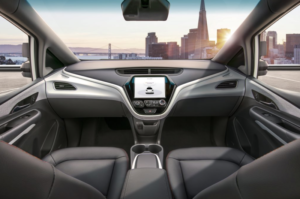By Halie B. Peacher
The sleek driverless vehicles that excited audiences when watching Will Smith in I, Robot[1] and Michael Keaton in Batman[2] will soon become our reality. From automotive companies to tech conglomerates, there is a race to see who can create a driverless car with the least amount of risk to consumers.[3] One of the greatest questions is how the government will choose to regulate the testing and the use of autonomous vehicles. On October 2, 2018, the United States Secretary of Transportation, Elaine Chao, stated that the department is “technology neutral” and that the big players in autonomous car manufacturing need to “work together.”[4] Thus, to push innovation forward, regulation of autonomous vehicles should not create constraints on an inevitable technology.[5] Additionally, regulation should protect the people, both as consumers and as bystanders.[6]
Thus far, thirty three states have either passed laws or are attempting to create legislation regarding the testing and use of autonomous vehicles.[7] The laws are geared toward the protection of civilians, but are far from uniform.[8] Specifically, the California Autonomous Vehicle Statute states that for a manufacturer to receive a testing permit, the manufacturer must evidence that it can provide insurance of $5,000,000.[9] In contrast, the Texas statute states that a driverless vehicle must be able to “request [an intervention]” by a human operator that will “promptly begin or resume performance of their entire dynamic driving task.”[10] Regulations will need to be uniform so that automakers are not constrained by meeting requirements for fifty different states when creating vehicles.[11] In essence, uniformity must balance creating less restrictive laws without stifling creativity.[12]
Finally, it is possible that companies such as Google, Uber, BMW, and Tesla can work together to enhance creativity while still being competitive. [13] Although State and Federal regulation will not be strict in enforcing this idea, precedent is likely to motivate these companies to share ideas.[14] For example, Waymo sued Uber for hiring Anthony Levandwoski, a co-founder of Waymo.[15] Waymo argued that Uber had knowledge that Levandowski downloaded files related to Google’s self-driving car technology.[16] Ultimately, Uber settled and agreed to pay Waymo “0.34% of its equity” which is a share of “$245 million.”[17]
Waymo shows that current and future challenges of trade secrets semi-impede development of autonomous vehicles.[18] Businesses in different sectors should work together to avoid losing equity. The top concerns for these businesses should not be who can make the most money or who can become the first to create an autonomous vehicle that meets all of the regulatory standards.[19] Rather, the manufacturer’s top concerns should be protecting society because autonomous vehicles create issues that will affect the consumer and the bystander through data privacy, incident response, and threat detection.[20] What better way to create a safe and efficient self-driving vehicle than an agreement between top manufacturing companies within the field, such as Waymo, GM, Mercedes-Benz, and Uber.[21] These companies are leaders in the self-driving technology and two heads are always better than one.[22]
[1] 20th Century Fox, i, Robot, YouTube (Dec. 18, 2016), https://www.youtube.com/watch?v= tY49M1F2CsA.
[2] Warner Bros. Pictures, Batman, YouTube (Jan. 29, 2010), https://www.youtube.com/watch?v= jXtAy1-xTwA.
[3] Nigel Parker, et al., Autonomous and Connected Vehicles: Navigating the Legal Issues, Allen & Overy LLP 1, 4-6 (2017), https://www.allenovery.com/SiteCollectionDocuments/Autonomous-and-connected-vehicles.pdf; see also Jack Karsten & Darrell West, The state of self-driving car laws across the U.S., Brookings Institute, https://www.brookings.edu/blog/techtank/2018/05/01/ the-state-of-self-driving-car-laws-across-the-u-s/.
[4] Erika Fry, How the Trump Administration Plans to Regulate Autonomous Vehicles and Drones, Fortune, Oct. 4, 2018, https://fortune.com/2018/10/02/trump-drones-regulation-self-driving-cars/.
[5] Nigel Parker, Autonomous and Connected Vehicles: Navigating the Legal Issues at 6.
[6] Id. at 10-11.
[7] See The State of Self-Driving Car Laws Across the U.S.
[8] Id.
[9] Cal. Veh. Code 13 § 227.02 – 227.18 (2018).
[10] Tex. S.B. No. 2205 at 4 (2017).
[11] Mark Aiello, et al., Top Legal Issues Facing the Automotive Industry in 2018, Foley & Lardner LLP 1, 27 (2018), https://m.foley.com/files/Publication/da584f92-2dc1-4c56-a399-601133b7c2a9/Presentation/ PublicationAttachment/aa6e2ba9-7d9c-41dc-a9db-627614a92038/Automotive%20Industry% 20White%20Paper_sp.pdf.
[12] Jessica S. Brodsky, Autonomous Vehicle Regulation: How an Uncertain Legal Landscape May Hit The Brakes on Self-Driving Cars, 31 Berkeley Tech. L.J. 851, 867-69 (2016).
[13] Nigel Parker, Autonomous and connected vehicles: navigating the legal issues at 5.
[14] How Automakers Can Survive The Self-Driving Era, ATKearney: Automotive (Oct. 10, 2018), https://www.atkearney.com/automotive/article?/a/how-automakers-can-survive-the-self-driving-era.
[15] Waymo LLC v. Uber Techs. Inc., 870 F.3d 1350 (2017); see also Nanding Chen, Waymo v. Uber: Surprise Settlement Five Days into Trial, Harv. L.J. of Law & Tech.: JOLT Digest (Mar. 3, 2018).
[16] Waymo LLC, 870 F.3d at 1354.
[17] See Nanding Chen, Waymo v. Uber: Surprise Settlement Five Days into Trial.
[18] Waymo LLC, 870 F.3d at 1350.
[19] See Mark Aiello, et al., Top Legal Issues Facing the Automotive Industry in 2018, at 2-4 (explaining the regulatory and commercial risks that autonomous car manufacturers will face).
[20] Id. at 15-19 (evidencing the top concern regarding autonomous vehicles is safety).
[21] David Welch & Elisabeth Behrmann, Who’s Winning the Self-Driving Car Race, Bloomberg: Hyperdrive (May 7, 2018), https://www.bloomberg.com/news/features/2018-05-07/who-s-winning-the-self-driving-car-race.
[22] Id.


